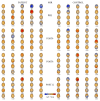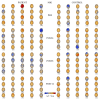Motor Imagery Training of Reaching-to-Grasp Movement Supplemented by a Virtual Environment in an Individual With Congenital Bilateral Transverse Upper-Limb Deficiency
- PMID: 33828507
- PMCID: PMC8019807
- DOI: 10.3389/fpsyg.2021.638780
Motor Imagery Training of Reaching-to-Grasp Movement Supplemented by a Virtual Environment in an Individual With Congenital Bilateral Transverse Upper-Limb Deficiency
Abstract
This study explored the effect of kinesthetic motor imagery training on reaching-to-grasp movement supplemented by a virtual environment in a patient with congenital bilateral transverse upper-limb deficiency. Based on a theoretical assumption, it is possible to conduct such training in this patient. The aim of this study was to evaluate whether cortical activity related to motor imagery of reaching and motor imagery of grasping of the right upper limb was changed by computer-aided imagery training (CAIT) in a patient who was born without upper limbs compared to a healthy control subject, as characterized by multi-channel electroencephalography (EEG) signals recorded before and 4, 8, and 12 weeks after CAIT. The main task during CAIT was to kinesthetically imagine the execution of reaching-to-grasp movements without any muscle activation, supplemented by computer visualization of movements provided by a special headset. Our experiment showed that CAIT can be conducted in the patient with higher vividness of imagery for reaching than grasping tasks. Our results confirm that CAIT can change brain activation patterns in areas related to motor planning and the execution of reaching and grasping movements, and that the effect was more pronounced in the patient than in the healthy control subject. The results show that CAIT has a different effect on the cortical activity related to the motor imagery of a reaching task than on the cortical activity related to the motor imagery of a grasping task. The change observed in the activation patterns could indicate CAIT-induced neuroplasticity, which could potentially be useful in rehabilitation or brain-computer interface purposes for such patients, especially before and after transplantation. This study was part of a registered experiment (ID: NCT04048083).
Keywords: EEG; amelia; grasping; mental training; neuroplasticity; reaching; transplantation.
Copyright © 2021 Mencel, Jaskólska, Marusiak, Kamiński, Kurzyński, Wołczowski, Jaskólski and Kisiel-Sajewicz.
Conflict of interest statement
The authors declare that the research was conducted in the absence of any commercial or financial relationships that could be construed as a potential conflict of interest.
Figures





Similar articles
-
High-density surface electromyography maps after computer-aided training in individual with congenital transverse deficiency: a case study.BMC Musculoskelet Disord. 2020 Oct 15;21(1):682. doi: 10.1186/s12891-020-03694-4. BMC Musculoskelet Disord. 2020. PMID: 33059684 Free PMC article.
-
Computer-aided training sensorimotor cortex functions in humans before the upper limb transplantation using virtual reality and sensory feedback.Comput Biol Med. 2017 Aug 1;87:311-321. doi: 10.1016/j.compbiomed.2017.06.010. Epub 2017 Jun 15. Comput Biol Med. 2017. PMID: 28641235
-
Effect of real-time cortical feedback in motor imagery-based mental practice training.NeuroRehabilitation. 2014;34(2):355-63. doi: 10.3233/NRE-131039. NeuroRehabilitation. 2014. PMID: 24401829 Clinical Trial.
-
Motor imagery reinforces brain compensation of reach-to-grasp movement after cervical spinal cord injury.Front Behav Neurosci. 2015 Sep 11;9:234. doi: 10.3389/fnbeh.2015.00234. eCollection 2015. Front Behav Neurosci. 2015. PMID: 26441568 Free PMC article. Review.
-
Reaching and grasping in autism spectrum disorder: a review of recent literature.Front Neurol. 2014 Jan 23;5:6. doi: 10.3389/fneur.2014.00006. eCollection 2014. Front Neurol. 2014. PMID: 24478753 Free PMC article. Review.
Cited by
-
Motor imagery training of goal-directed reaching in relation to imagery of reaching and grasping in healthy people.Sci Rep. 2022 Nov 3;12(1):18610. doi: 10.1038/s41598-022-21890-1. Sci Rep. 2022. PMID: 36329083 Free PMC article. Clinical Trial.
-
Brain-Computer interface control of stepping from invasive electrocorticography upper-limb motor imagery in a patient with quadriplegia.Front Hum Neurosci. 2023 Jan 9;16:1077416. doi: 10.3389/fnhum.2022.1077416. eCollection 2022. Front Hum Neurosci. 2023. PMID: 36776220 Free PMC article.
-
The Impact of Different Telerehabilitation Methods on Peripheral Muscle Strength and Aerobic Capacity in COPD Patients: A Randomized Controlled Trial.Adv Respir Med. 2024 Sep 20;92(5):370-383. doi: 10.3390/arm92050035. Adv Respir Med. 2024. PMID: 39311114 Free PMC article. Clinical Trial.
References
Associated data
LinkOut - more resources
Full Text Sources
Other Literature Sources
Medical

